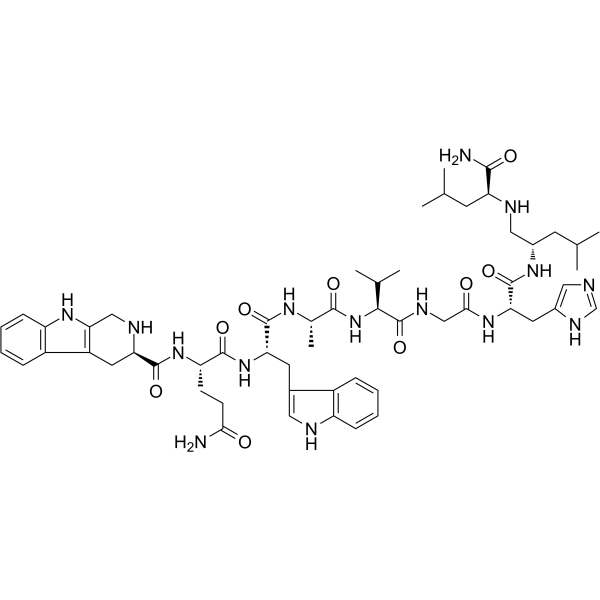RC-3095

RC-3095 structure
|
Common Name | RC-3095 | ||
|---|---|---|---|---|
| CAS Number | 138147-78-1 | Molecular Weight | 1106.322 | |
| Density | 1.3±0.1 g/cm3 | Boiling Point | 1547.9±65.0 °C at 760 mmHg | |
| Molecular Formula | C56H79N15O9 | Melting Point | N/A | |
| MSDS | USA | Flash Point | 889.9±34.3 °C | |
Use of RC-3095RC-3095 is a bombesin/gastrin releasing peptide receptor antagonist[1]. |
| Name | [1(R),6[S-(R*,R*)]]-N2-[(2,3,4,9-Tetrahydro-1H-pyrido[3,4-b]indol-3-yl)carbonyl]-L-glutaminyl-L-tryptophyl-L-alanyl-L-valylglycyl-N-[1-[[[1-(aminocarbonyl)-3-methylbutyl]amino]methyl]-3-methylbutyl]-L-histidinamide |
|---|---|
| Synonym | More Synonyms |
| Description | RC-3095 is a bombesin/gastrin releasing peptide receptor antagonist[1]. |
|---|---|
| Related Catalog | |
| References |
| Density | 1.3±0.1 g/cm3 |
|---|---|
| Boiling Point | 1547.9±65.0 °C at 760 mmHg |
| Molecular Formula | C56H79N15O9 |
| Molecular Weight | 1106.322 |
| Flash Point | 889.9±34.3 °C |
| Exact Mass | 1105.618530 |
| LogP | 1.05 |
| Vapour Pressure | 0.0±0.3 mmHg at 25°C |
| Index of Refraction | 1.610 |
| Personal Protective Equipment | Eyeshields;Gloves;type N95 (US);type P1 (EN143) respirator filter |
|---|---|
| RIDADR | NONH for all modes of transport |
|
The role of central gastrin-releasing peptide and neuromedin B receptors in the modulation of scratching behavior in rats.
J. Pharmacol. Exp. Ther. 337(3) , 822-9, (2011) Bombesin is a pruritogenic agent that causes intense itch-scratching activity in rodents. Bombesin has high affinity for the gastrin-releasing peptide (GRP) receptor (GRPr) and the neuromedin B (NMB) ... |
|
|
Facilitation of the inhibitory transmission by gastrin-releasing peptide in the anterior cingulate cortex.
Mol. Pain 6 , 52, (2010) Gastrin-releasing peptide (GRP) has been proposed as a peptidergic molecule for behavioral fear and itching. Immunohistochemistry and in situ hybridization studies have shown that GRP and GRP receptor... |
|
|
New agonist- and antagonist-based treatment approaches for advanced prostate cancer.
J. Int. Med. Res. 40(4) , 1217-26, (2012) Increased understanding of prostate cancer biology has led to new treatment strategies and promising new agents for treating prostate cancer, in particular peptide-based agonists and antagonists. In t... |
| L-Histidinamide, N-[[(3R)-2,3,4,9-tetrahydro-1H-pyrido[3,4-b]indol-3-yl]carbonyl]-L-glutaminyl-L-tryptophylalanyl-L-valylglycyl-N-[1-[[[(1S)-1-(aminocarbonyl)-3-methylbutyl]amino]methyl]-3-methylbu tyl]- |
| N-[(3R)-2,3,4,9-Tetrahydro-1H-β-carbolin-3-ylcarbonyl]-L-glutaminyl-L-tryptophylalanyl-L-valylglycyl-N-(1-{[(2S)-1-amino-4-methyl-1-oxo-2-pentanyl]amino}-4-methyl-2-pentanyl)-L-histidinamide |